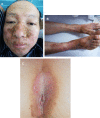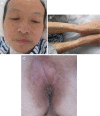Glucagonoma syndrome: a case report with focus on skin disorders
- PMID: 25152626
- PMCID: PMC4140234
- DOI: 10.2147/OTT.S66285
Glucagonoma syndrome: a case report with focus on skin disorders
Abstract
Glucagonoma syndrome is a rare paraneoplastic phenomenon. Necrolytic migratory erythema is often one of the first presenting symptoms. We report a case of a 55-year-old man with a 2-year history of recalcitrant eruption. Abdominal computer tomography was performed, which revealed a tumor in the tail of the pancreas. After pancreatectomy, his cutaneous lesions vanished in a few days. Skin symptoms are important, as they are often essential for early diagnosis of glucagonoma syndrome and may prevent metastatic disease; hence, in this report, we focus on skin disorders in glucagonoma syndrome.
Keywords: necrolytic migratory erythema.
Figures




References
-
- Mallinson CN, Bloom SR, Warin AP, Salmon PR, Cox B. A glucagonoma syndrome. Lancet. 1974;2(7871):1–5. - PubMed
-
- Johnson SM, Smoller BR, Lamps LW, Horn TD. Necrolytic migratory erythema as the only presenting sign of a glucagonoma. J Am Acad Dermatol. 2003;49(2):325–328. - PubMed
-
- Becker SW, Kahn D, Rothman S. Cutaneous manifestations of internal malignant tumors. Arch Dermatol Syphilol. 1942;45:1069–1080. - PubMed
-
- McGavran M, Unger RH, Recant L, Polk HC, Kilo C, Levin ME. A glucagon secreting alpha-cell carcinoma of the pancreas. N Engl J Med. 1966;274:1408–1413. - PubMed
-
- Mullans E, Cohen R. Iatrogenic NME: a case report and review of nonglucagonoma-associated NME. J Am Acad Dermatol. 1998;38:866–873. - PubMed
Publication types
LinkOut - more resources
Full Text Sources
Other Literature Sources

